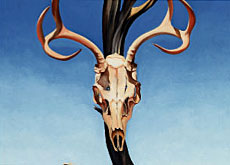Zurich shows there’s more to O’Keeffe than flowers

The fine arts museum in Zurich is staging the first major European exhibition of works by an artist long regarded as a cultural icon in the United States.
Georgia O’Keeffe is one of the great figures in 20th century art – yet her paintings are a rarity in Europe’s public and private collections.
As a result nearly all of the 74 works on show are on loan from American museums and collectors.
But the European public has until now predominantly associated O’Keeffe with her large-format flower pictures familiar from reproductions, such as posters, postcards and calendars.
These pictures figure prominently but the retrospective reveals the much wider scope of the work of an artist who died shortly before her 100th birthday in 1986.
Exhibition curator Bice Curiger told swissinfo that there were two main reasons for Europe’s comparative neglect of this great artist.
“To start with, the museums didn’t buy her paintings after World War II because they didn’t consider them to be sufficiently abstract,” she said.
“Secondly, they were expensive at a time when the dollar was high. A Cezanne would fetch the same price so European museums and private collectors tended to favour European artists.”
As the Zurich exhibition makes clear, it was a missed opportunity.
Desert travels
Born in Wisconsin in 1897, O’Keeffe was strongly influenced by the wide-open spaces both there and in New Mexico, where she settled in later life.
The big skies and snow-laden scenery featured in some of the paintings reflect childhood memories of her upbringing in the Midwest, while others are the product of travelling around New Mexico’s remote desert regions.
Her trips to the latter resulted in paintings of animal skulls and pelvic bones, and she also produced a series of exquisitely-coloured ochre, adobe buildings in New Mexico.
Skyscraper paintings
Georgia O’Keeffe had burst onto the American art scene in 1916, when her abstract charcoal drawings were exhibited in the New York gallery of Alfred Stieglitz, a pioneering photographer and promoter of avant-garde art.
She later married Stieglitz and they initially lived in rooms on the 12th floor of a New York hotel. This period resulted in a series, also featured in the exhibition, of boldly-coloured skyscraper paintings.
Interestingly, says Curiger, O’Keeffe never belonged to any particular art movement: “After the war this was a problem for her, especially in Europe, because American art tended to be presented in packages labelled ‘pop art’ or ‘abstract expressionism’.
“She didn’t belong to any of them and was neither a purely abstract painter nor a purely figurative one.”
The exhibition ends on February 1.
swissinfo, Richard Dawson in Zurich
Zurich’s fine arts museum is the first in Europe to stage a major exhibition of works by the American artist Georgia O’Keeffe (1897-1986).
Born in Wisconsin, O’Keeffe was inspired by the region’s wide-open spaces and by the desert landscapes of New Mexico.
Her first exhibition was in 1916 in the New York gallery of photographer Alfred Stieglitz, whom she later married.
The Zurich exhibition ends on February 1.

In compliance with the JTI standards
More: SWI swissinfo.ch certified by the Journalism Trust Initiative








You can find an overview of ongoing debates with our journalists here . Please join us!
If you want to start a conversation about a topic raised in this article or want to report factual errors, email us at english@swissinfo.ch.